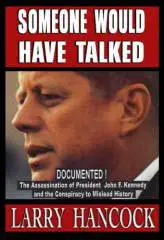The Assassination of John F. Kennedy (original) (raw)
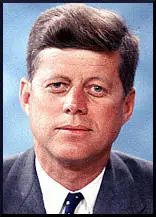
On the occasion of Martin Luther King Jr. Day, a group of over 60 prominent American citizens is calling upon Congress to reopen the investigations into the assassinations of President John F. Kennedy, Malcolm X, Martin Luther King Jr., and Senator Robert F. Kennedy. Signers of the joint statement include Isaac Newton Farris Jr., nephew of Reverend King and past president of the Southern Christian Leadership Conference; Reverend James M. Lawson Jr., a close collaborator of Reverend King; and Robert F. Kennedy Jr. and Kathleen Kennedy Townsend, children of the late senator. The declaration is also signed by numerous historians, journalists, lawyers and other experts on the four major assassinations. I am the only non-American who has been asked to sign this statement. For further details see the statement.
Don B. Reynolds
Don B. Reynolds told B. Everett Jordan and his committee on 22nd November, 1963, that Lyndon B. Johnson had demanded that he provided kickbacks in return for him agreeing to this life insurance policy. This included a 585Magnavoxstereo.Reynoldswasalsotoldby[WalterJenkins](JFKjenkins.htm)thathehadtopayfor585 Magnavox stereo. Reynolds was also told by Walter Jenkins that he had to pay for 585Magnavoxstereo.Reynoldswasalsotoldby[WalterJenkins](JFKjenkins.htm)thathehadtopayfor1,200 worth of advertising on KTBC, Johnson's television station in Austin. Reynolds had paperwork for this transaction including a delivery note that indicated the stereo had been sent to the home of Johnson.
Reynolds also told of seeing a suitcase full of money which Bobby Baker described as a "$100,000 payoff to Johnson for his role in securing the Fort Worth TFX contract". Reynolds also provided evidence against Matthew H. McCloskey. He suggested that he given $25,000 to Baker in order to get the contract to build the District of Columbia Stadium. His testimony came to an end when news arrived that President John F. Kennedy had been assassinated. (see more here)
Lisa Howard
In April 1963 Lisa Howard arrived in Cuba to make a documentary on the country. In an interview with Howard, Fidel Castro agreed that a rapprochement with Washington was desirable. On her return Howard met with the Central Intelligence Agency. Deputy Director Richard Helms reported to John F. Kennedy on Howard's view that "Fidel Castro is looking for a way to reach a rapprochement with the United States." After detailing her observations about Castro's political power, disagreements with his colleagues and Soviet troops in Cuba, the memo concluded that "Howard definitely wants to impress the U.S. Government with two facts: Castro is ready to discuss rapprochement and she herself is ready to discuss it with him if asked to do so by the US Government."
CIA Director John McCone was strongly opposed to Howard being involved with these negotiations with Castro. He argued that it might "leak and compromise a number of CIA operations against Castro". In a memorandum to McGeorge Bundy, McCone commented that the "Lisa Howard report be handled in the most limited and sensitive manner," and "that no active steps be taken on the rapprochement matter at this time." (see more here)
Roger Craig
Roger Craig was on duty in Dallas on 22nd November, 1963. After hearing the firing at President John F. Kennedy he ran towards the Grassy Knoll where he interviewed witnesses to the shooting. About 15 minutes later he saw a man running from the back door of the Texas School Book Depository down the slope to Elm Street. He then got into a Nash station wagon.
Craig saw the man again in the office of Captain Will Fritz. It was the recently arrested Lee Harvey Oswald. When Craig told his story about the man being picked up by the station wagon, Oswald replied: "That station wagon belongs to Mrs. Paine... Don't try to tie her into this. She had nothing to do with it." (see more here)
Evelyn Lincoln
Lincoln later claimed that in November, 1963, Kennedy decided that because of the emerging Bobby Baker scandal he was going to drop Lyndon B. Johnson as his running mate in the 1964 election. John F. Kennedy told Lincoln that he was going to replace Johnson with Terry Sanford. In her book, Kennedy and Johnson (1968): "As Mr. Kennedy sat in the rocker in my office, his head resting on its back he placed his left leg across his right knee. He rocked slightly as he talked. In a slow pensive voice he said to me, 'You know if I am re-elected in sixty-four, I am going to spend more and more time toward making government service an honorable career. I would like to tailor the executive and legislative branches of government so that they can keep up with the tremendous strides and progress being made in other fields.' 'I am going to advocate changing some of the outmoded rules and regulations in the Congress, such as the seniority rule. To do this I will need as a running mate in sixty-four a man who believes as I do.' Mrs. Lincoln went on to write "I was fascinated by this conversation and wrote it down verbatim in my diary. Now I asked, 'Who is your choice as a running-mate?' 'He looked straight ahead, and without hesitating he replied, 'at this time I am thinking about Governor Terry Sanford of North Carolina. But it will not be Lyndon." (see more here)
Billy James Hargis
Billy James Hargis believed that the John F. Kennedy was assassinated as a result of a communist conspiracy and in 1964 published a book attacking communism entitled The Far Left. He also believed that the KGB and the American Communist Party tried to place the blame on right-wing organizations. "In spite of the absolute, indisputable evidence that Lee Oswald’s mind was molded by Communist conspiracy propaganda, that his hatred was of the American free enterprise system and all it embraces, and that no one with even the remotest connection with what is considered to be the extreme right has any remote connection with the entire hideous affair, the propaganda voices of the left continue to try to blame right wing conservatives for creating the atmosphere of 'hate' which caused Oswald to commit the assassination of President Kennedy. Do they really think the American people are that stupid? There is no doubt in my mind that the Communist assassin, Lee Oswald, intended to kill the President of the United States and disappear in the confused crowd, thus letting the conservative, anti-Communist element of Dallas take the blame. (see more here)
C. D. Jackson
After the election of John F. Kennedy in 1960 Jackson left the White House and became publisher of Life Magazine. When Kennedy was assassinated, Jackson purchased the Zapruder Film on behalf of Life. David Lifton points out in The Great Zapruder Film Hoax (2004) that: "Abraham Zapruder in fact sold the film to Time-Life for the sum of 150,000−about150,000 - about 150,000−about900,000 dollars in today's money... Moreover, although Life had a copy of the film, it did little to maximize the return on its extraordinary investment. Specifically, it did not sell this unique property - as a film - to any broadcast media or permit it to be seen in motion, the logical way to maximize the financial return on its investment... A closer look revealed something else. The film wasn't just sold to Life - the person whose name was on the agreement was C. D. Jackson." Jackson published individual frames of Zapruder's film but did not allow the film to be screened in its entirety. (see more here)
Sylvia Odio
On 25th September, 1963, Sylvia Odio had a visit from three men who claimed they were from New Orleans. Two of the men, Leopoldo and Angelo, said they were members of the Junta Revolucionaria. The third man, Leon, was introduced as an American sympathizer who was willing to take part in the assassination of Fidel Castro. After she told them that she was unwilling to get involved in any criminal activity, the three men left.
The following day Leopoldo phoned Odio and told her that Leon was a former Marine and that he was an expert marksman. He added that Leon had said “we Cubans, we did not have the guts because we should have assassinated Kennedy after the Bay of Pigs”. It is believed that Bernardo De Torres was Leopoldo and Edwin Collins was Angelo. (see more here)
Loran Eugene Hall
In April 1963 Gerry P. Hemming introduced Loran Eugene Hall to John Martino. A few days later Hall met Santo Trafficante, Sam Giancana and Johnny Roselli at a Miami Beach hotel. Hall later reported that Giancana gave Eddie Bayo $15,000 as a down payment for a raid on Cuba. Bayo claimed that two officers in the Red Army based in Cuba wanted to defect to the United States. Bayo added that these men wanted to pass on details about atomic warheads and missiles that were still in Cuba despite the agreement that followed the Cuban Missile Crisis.
Bayo's story was eventually taken up by several members of the anti-Castro community. William Pawley became convinced that it was vitally important to help get these Soviet officers out of Cuba. To help this happen he contacted James Eastland, the chairman of the Senate Internal Security Subcommittee. Pawley also contacted Ted Shackley, head of the CIA's JM WAVE station in Miami. Shackley decided to help Pawley organize what became known as Operation Tilt. He also assigned Rip Robertson to help with the operation. David Sanchez Morales, another CIA agent, also became involved in this attempt to bring out these two Soviet officers. (see more here)
Malcolm (Mac) Wallace
Barr McClellan, the author of Blood, Money & Power: How LBJ Killed JFK (2003) later claimed that the killing of Kennedy was paid for by oil millionaires such as Clint Murchison and Haroldson L. Hunt. McClellan claims that Edward Clark got 2millionforthiswork.ThedeathofKennedyallowedtheoildepletionallowancetobekeptat27.5percent.ItremainedunchangedduringtheJohnsonpresidency.AccordingtoMcClellanthisresultedinasavingofover2 million for this work. The death of Kennedy allowed the oil depletion allowance to be kept at 27.5 per cent. It remained unchanged during the Johnson presidency. According to McClellan this resulted in a saving of over 2millionforthiswork.ThedeathofKennedyallowedtheoildepletionallowancetobekeptat27.5percent.ItremainedunchangedduringtheJohnsonpresidency.AccordingtoMcClellanthisresultedinasavingofover100 million to the American oil industry. Soon after Johnson left office it dropped to 15 per cent.
Wallace went to work for Harry Lewis and L & G Oil. In 1970 he returned to Dallas and began pressing Clark for more money for his part in the assassination of John F. Kennedy. According to McClellan it was then decided to kill Wallace. "He had to be eliminated. After driving to see his daughter in Troup, Texas, he went by L & G's offices in Longview, Texas. There his exhaust was rigged for part of it to flow into his car."On 7th January, 1971, Malcolm Wallace was killed while driving into Pittsburg, Texas. He appeared to have fallen asleep and after leaving the road crashed his car. Wallace died of massive head injuries. (see more here)
William C. Sullivan
When John F. Kennedy was assassinated in Dallas, William C. Sullivan was put in charge of the bureau's in-house investigation. He was expected to work closely with John M. Whitten, who was running the CIA investgation of Lee Harvey Oswald. Whitten and his staff of 30 officers, were sent a large amount of information from the FBI. According to Gerald D. McKnight "the FBI deluged his branch with thousands of reports containing bits and fragments of witness testimony that required laborious and time-consuming name checks." Whitten later described most of this FBI material as "weirdo stuff". As a result of this initial investigation, Whitten told Richard Helms that he believed that Oswald had acted alone in the assassination of Kennedy.
However, on 6th December, Nicholas Katzenbach invited Whitten and Birch O'Neal, Angleton's trusted deputy and senior Special Investigative Group (SIG) officer to read Commission Document 1 (CD1), the report that the FBI had written on Oswald. Whitten now realized that the FBI had been withholding important information on Oswald from him. He also discovered that Helms had not been providing him all of the agency's available files on Oswald. This included Oswald's political activities in the months preceding the assassination. (see more here)
Eladio del Valle
Eladio del Valle was murdered on 22nd February, 1967. Police reported that del Valle had been tortured, shot in the heart at point-blank range, and his skull split open with an axe. His murder has never been solved. He died only hours after his friend, David Ferrie. Diego Gonzales Tendera, a close friend, later claimed de Valle was murdered because of his involvement in the assassination of President John F. Kennedy. A senior member of the Cuban Secret Service, Fabian Escalante, agreed: "In 1962 Eladio Del Valle tried to infiltrate Cuba with a commando group of 22 men but their boat had an English key - a little island. In the middle of 1962. Of course, we knew this. I tell you about this, because one of our agents who was one of the people helping to bring this group to Cuba, was a man of very little education. They talked English on many occasions on this little island with Eladio Del Valle told this person, on many occasions, that Kennedy must be killed to solve the Cuban problem. After that we had another piece of information on Eladio Del Valle. This was offered to us by Tony Cuesta. He told us that Eladio Del Valle was one of the people involved in the assassination plot against Kennedy." (see more here)
Abraham Bolden
In 1961 President John F. Kennedy appointed Abraham Bolden as part of the Secret Service White House detail. According to Jim Marrs (Crossfire: The Plt That Killed Kennedy), Bolden was personally selected by Kennedy "in an attempt to integrate the previously all-white Secret Service detail"...
Bolden claimed that in October, 1963, the Chicago Secret Service office received a teletype from the Federal Bureau of Investigation warning that an attempt would be made to kill President John F. Kennedy by a four-man Cuban hit squad when he visited the city on 2nd November. Armed with high-powered rifles, the men from "a dissident Cuban group". According to investigative journalist Edwin Black, the Secret Service arrested two suspects, however, they were eventually released.
Abraham Bolden later discovered that this information was being kept from the Warren Commission. When he complained about this he was warned "to keep his mouth shut". Bolden decided to travel to Washington where he telephoned Warren Commission Counsel J. Lee Rankin. Bolden was arrested and taken back to Chicago where he was charged with discussing a bribe with two known counterfeiters. He was eventually found guilty of accepting a bribe and spent six years in prison. When he tried to draw attention to his case, he was placed in solitary confinement. (see more here)

Websites
Time Search: Spartacus Educational
Forum Debates
The Kennedy Assassination: Beyond Conspiracy
Assassination, Terrorism and the Arms Trade
The Role of the Left in the Cover-Up of the John F. Kennedy Assassination
The Role of the Conspiracy Theory in Shaping Modern History
A Unified Theory of CIA Covert Activities: 1960-1990
Related Reading
Related Reading
Related Reading
Related Reading

Related Reading
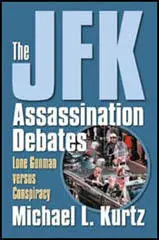
Related Reading

Related Reading
The Assassination of John F. Kennedy Photographic Archive
Related Reading
Related Reading
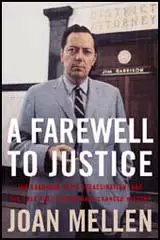
Related Reading
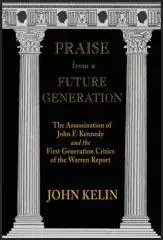
Praise from a Future Generation
Related Reading
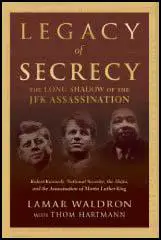
_SIDEBAR_BOTTOM













